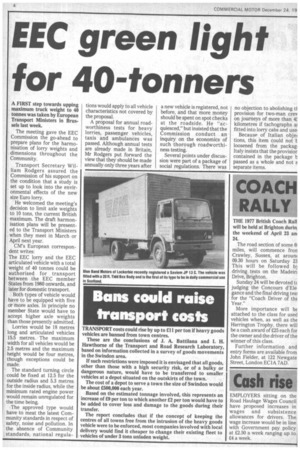EEC green light for 40-tonners
Page 6

If you've noticed an error in this article please click here to report it so we can fix it.
A FIRST step towards upping maximum truck weight to 40 tonnes was taken by European Transport Ministers in Brussels last week.
The meeting gave the EEC Commission the go-ahead to prepare plans for the harmonisation of lorry weights and dimensions throughout the Community.
Transport Secretary William Rodgers assured the Commission of his support on the condition that a study is set up to look into the environmental effects of the new size Euro lorry.
He welcomed the meeting's decision to limit axle weights to 10 tons, the current British maximum. The draft harmonisation plans will be present ed to the Transport Ministers when they meet in March or April next year.
CM's European correspondent writes: The EEC lorry and the EEC articulated vehicle with a total weight of 40 tonnes could be authorised for transport between the EEC member States from 1980 onwards, and later for domestic transport.
Both types of vehicle would have to be equipped with five or more axles. In principle no member State would have to accept higher axle weights than those presently admitted.
Lorries would be 18 metres long and articulated vehicles 15.5 metres. The maximum width for all vehicles would be 2.5 metres and the maximum height would be four metres, though exceptions could be made.
The standard turning circle could be fixed at 12.5 for the outside radius and 5.3 metres for the inside radius, while the minimum rated engine power would remain unregulated for the time being.
The approved type would have to meat the latest Community standards in respect of safety, noise and pollution. In the absence of Community standards, national regula tions would apply to all vehicle characteristics not covered by the proposal.
A proposal for annual roadworthiness tests for heavy lorries, passenger vehicles, taxis and ambulances was passed. Although annual tests are already made in Britain, Mr Rodgers put forward the view that they should be made annually only three years after a new vehicle is registered, not before, and that more money should be spent on spot checks at the roadside. He "acquiesced," but insisted that the Commission conduct an inquiry on the economics of such thorough roadworthiness testing.
Several points under discussion were part of a package of social regulations. There was no objection to abolishing provision for two-man crev on journeys of more than 4t kilometres if tachographs at fitted into lorry cabs and use Because of Italian obje( tions, this item could not t loosened from the packagi Italy insists that the provisior contained in the package b passed as a whole and not a separate items.




































































